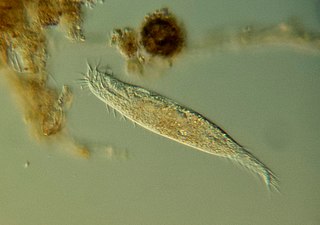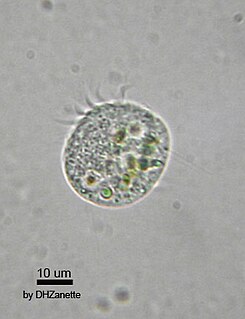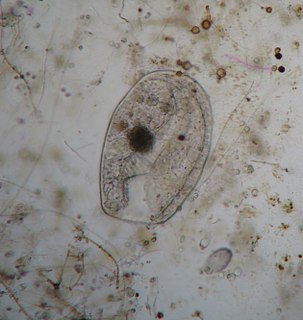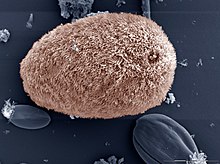
The spirotrichs are a large and diverse group of ciliate protozoa. They typically have prominent oral cilia in the form of a series of polykinetids, called the adoral zone of membranelles, beginning anterior to the oral cavity and running down to the left side of the mouth. There may also be one or two paroral membranes on its right side. The body cilia are fused to form polykinetids called cirri in some, and are sparse to absent in others.

The heterotrichs are a class of ciliates. They typically have a prominent adoral zone of membranelles circling the mouth, used in locomotion and feeding, and shorter cilia on the rest of the body. Many species are highly contractile, and are typically compressed or conical in form. These include some of the largest protozoa, such as Stentor and Spirostomum, as well as many brightly pigmented forms, such as certain Blepharisma.
The plagiopylids are a small order of ciliates, including a few forms common in anaerobic habitats.

The peniculids are an order of ciliate protozoa, including the well-known Paramecium and related genera, such as Frontonia, Stokesia, Urocentrum and Lembadion. Most are relatively large, freshwater forms that feed by sweeping smaller organisms into the mouth. They have weird life cycles, and in many cases do not even form resting cysts.
Extrusomes are membrane-bound structures in some eukaryotes which, under certain conditions, discharge their contents outside the cell. There are a variety of different types, probably not homologous, and serving various functions.

The Phyllopharyngea are a class of ciliates, including some which are extremely specialized. Motile cells typically have cilia restricted to the ventral surface, or some part thereof, arising from monokinetids with a characteristic ultrastructure. In both chonotrichs and suctoria, however, only newly formed cells are motile and the sessile adults have undergone considerable modifications of form and appearance. Chonotrichs, found mainly on crustaceans, are vase-shaped, with cilia restricted to a funnel leading down into the mouth. Mature suctorians lack cilia altogether, and initially were not classified as ciliates.

The hypotrichs are a group of ciliated protozoa, common in fresh water, salt water, soil and moss. Hypotrichs possess compound ciliary organelles called "cirri," which are made up of thick tufts of cilia, sparsely distributed on the ventral surface of the cell. The multiple fused cilia which form a cirrus function together as a unit, enabling the organism to crawl along solid substrates such as submerged debris or sediments. Hypotrichs typically possess a large oral aperture, bordered on one side by a wreath or collar of membranelles, forming an "adoral zone of membranelles," or AZM.

The stichotrichs were a proposed group of ciliates, in the class Spirotrichea. In a classification system proposed by Eugene Small and Denis Lynn in 1985, Stichotrichia formed a subclass containing four orders: Stichotrichida, Urostylida, Sporadotrichida and Plagiotomida. Although the group was made up of species traditionally classified among the "hypotrichs"--ciliates possessing compound ciliary organelles called cirri--it excluded euplotid ciliates such as Euplotes and Diophrys, which were placed in the subclass Hypotrichia. In later classifications proposed by Denis Lynn, Stichotrichia omits the order Plagiotomida.

Holotricha is an order of ciliates. The classification has fallen from use as a formal taxon, but the terms "holotrich" and "holotrichous" are still applied descriptively to organisms with cilia of uniform length distributed evenly over the surface of the body.

The oligotrichs are a group of ciliates, included among the spirotrichs. They have prominent oral cilia, which are arranged as a collar and lapel, in contrast to the choreotrichs where they form a complete circle. The body cilia are reduced to a girdle and ventral cilia. In Halteria and its relatives, they form bristles or cirri; however these forms may be closer relatives of the stichotrichs than of other oligotrichs. These organisms are very common in plankton communities, especially in marine systems. Usually found in concentrations of about 1 per ml, they are the most important herbivores in the sea, the first link in the food chain.

Parameciidae are a family of ciliates in the order Peniculida; the body has differentiated anterior and posterior ends and is bounded by a hard but elastic pellicle. The family contains only the genus Paramecium, as well as the genus incertae sedisPhysanter.

Colpoda is a genus of ciliates in the class Colpodea, order Colpodida, and family Colpodidae.
Karyorelictea is a class of ciliates in the subphylum Postciliodesmatophora. Most species are members of the microbenthos community, that is, microscopic organisms found in the marine interstitial habitat, though one genus, Loxodes, is found in freshwater.

The ciliates are a group of protozoans characterized by the presence of hair-like organelles called cilia, which are identical in structure to eukaryotic flagella, but are in general shorter and present in much larger numbers, with a different undulating pattern than flagella. Cilia occur in all members of the group and are variously used in swimming, crawling, attachment, feeding, and sensation.

Euplotes is a genus of ciliates in the subclass Euplotia. Species are widely distributed in marine and freshwater environments, as well as soil and moss. Most members of the genus are free-living, but two species have been recorded as commensal organisms in the digestive tracts of sea urchins.

Postciliodesmatophora is a subphylum of ciliates.

Intramacronucleata is a subphylum of ciliates. The group is characterized by the manner in which division of the macronucleus is accomplished during binary fission of the cell. In ciliates of this subphylum, division of the macronucleus is achieved by the action of microtubules which are assembled inside the macronucleus itself. This is in contrast to heterotrich ciliates of the subphylum Postciliodesmatophora, in which division of the macronucleus relies on microtubules formed outside the macronuclear envelope.

Bursaria is a genus of ciliates in the class Colpodea. They are relatively large and feed on other protists in freshwater habitats.
Glaucoma is a genus of freshwater ciliates in the Oligohymenophorea. Cells in this genus are between 30–150 µm long, and have three membranelles that surround the oral cavity. Two of the membranelles are used to sweep water towards the mouth, while the third acts like a sieve to strain out food particles for ingestion. In contrast, many other filter-feeding oligohymenophoreans use the paroral membrane, also known as an undulating membrane, for this purpose, but the paroral is not well-developed in Glaucoma.

Tracheloraphis is a genus of ciliates in the family Trachelocercidae.















